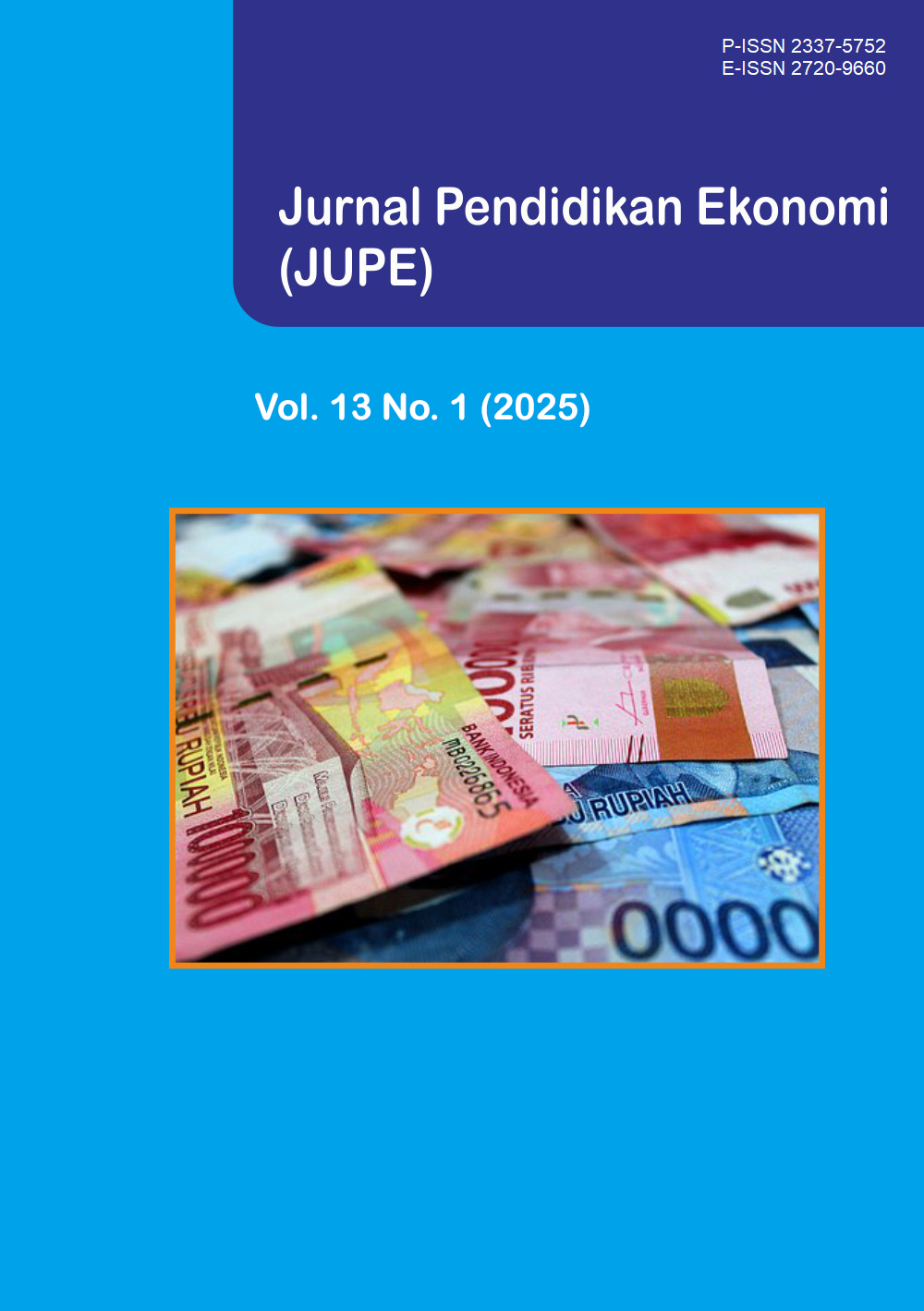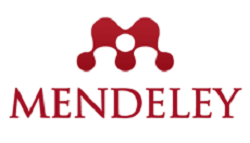Analisis faktor-faktor yang mempengaruhi permintaan uang di provinsi Bali menggunakan pendekatan error correction model (ECM)
DOI:
https://doi.org/10.26740/jupe.v13n1.p31-43Keywords:
Money Demand, Inflation, Interest Rate, GDP, BaliAbstract
Demand for money is an important indicator in the economy that reflects the needs of the public and economic actors for cash and non-cash money for transactions, investments, and reserves. Bali Province, as one of the main tourist destinations in Indonesia, has unique and interesting economic dynamics to study, especially in terms of money demand. Over the period 2000-2023, changes in the demand for money in Bali Province were influenced by various macroeconomic factors such as inflation, interest rates, and Gross Domestic Product (GDP). This study aims to analyze the factors that influence the demand for money in Bali Province by using the Domowitz-El Badawi Error Corection Model (ECM) on secondary data obtained from the Bali Central Bureau of Statistics. The result revealed 24.4% of the imbalance from the previous period will be adjusted in the current period. This negative and significant coefficient indicates that the ECM model used is valid. In the long run, inflation and GDP have a positive effect on money demand, while interest rates have a negative effect. In the short term, inflation has a positive effect, while the BI rate has a negative effect on money demand. However, GDP shows a negative coefficient, which may indicate the influence of other factors in the short term.Downloads
References
Ajija, S. R., Sari, D. W., Setianto, R. H., & Primanthi, M. (2011). Cara Cerdas Menguasai Eviews. Salemba Empat.
Astuti, P. Y., & Saputro, D. R. S. (2018). Kointegrasi dan Estimasi Error Correction Model (ECM)- Engle-Granger. Seminar Nasional Pendidikan Matematika Ahmad Dahlan, 2407–7496, 131–135.
Astuti, R. D. (2016). Analisis makro kinerja pasar modal Indonesia dengan pendekatan Error Correction Model (ECM). Economic Journal of Emerging Markets, 6(1), 13–32. https://doi.org/10.20885/ejem.v6i1.6979
Boediono. (2005). Ekonomi Moneter, Seri Sinopsis Pengantar Ilmu Ekonomi No.5. BPFE-Yogyakarta.
Dewi, S. L. (2013). Pengaruh PAD, PMA dan Inflasi Terhadap Pertumbuhan Ekonomi Provinsi Bali. E-Jurnal Ekonomi Pembangunan Universitas Udayana, 2(11), 502–512.
Firmansyah, & Satrianto, A. (2024). Pengaruh Ketidakpastian Inflasi Dan Ketidakpastian Ekonomi Terhadap Permintaan Uang Di Indonesia. Media Riset Ekonomi Pembangunan ….
Friedman, M. (1956). The Quantity Theory of Money A Restatement. In: Studies in the Quantity Theory of Money. University of Chicago Press, 3–21. https://www.scirp.org/reference/referencespapers?referenceid=2244481
Friedman, M. (1998). The role of monetary policy. The American Economic Review, 58(1), 1–17. https://doi.org/10.4324/9781912281091
Ghozali, I. (2018). Aplikasi Analisis Multivariate dengan Program IBM SPSS. Bandan Penerbit Undip.
Hasanah, H., & Azam Achsani, N. (2008). Perilaku Agregat Moneter Dalam Sistem Keuangan/ Perbankan Ganda Di Indonesia. Jurnal Ekonomi Dan Bisnis Indonesia, 23(2), 143–163. http://download.garuda.kemdikbud.go.id/article.php?article=611811&val=7317&title=PERILAKU AGREGAT MONETER DALAM SISTEM KEUANGANPERBANKAN GANDA DI INDONESIA
Insukindro. (1999). Pemilihan Model Ekonomi Empirik Dengan Pendekatan Koreksi Kesalahan. Jurnal Ekonomi Dan Bisnis Indonesia,Universitas Gadjah Mada, Volume 14, 1–8.
Istikomah, N., Khairunnisa, K. Y., Kusuma, A. D., & Ghifari, M. D. (2020). Permintaan Uang Di Indonesia : Analisis Variabel Makro Ekonomi. Jurnal Pendidikan Ekonomi Indonesia, 2(1), 113–119.
Kydland, E. (1981). TIME TO BUILD AND AGGREGATE FLUCTUATIONS. The Guthrie Journal, 50(4), 213–215. https://doi.org/10.3138/guthrie.50.4.213
Mankiw, N. G. (2006). Makroekonomi (S. wibi hrdani, M.M, Devri Barnadi, S.E (ed.); 6th ed.). Penerbit Erlangga.
Marliana, N. W. S., & Yasa, I. N. M. (2024). Pengaruh Pdb, Defisit Anggaran, Cadangan Devisa, Suku Bunga Luar Negeri Terhadap Utang Luar Negeri Indonesia. E-Jurnal Ekonomi Dan Bisnis Universitas Udayana, 13(04), 718. https://doi.org/10.24843/eeb.2024.v13.i04.p07
Maruddani, D. A. I., Tarno, & Anisah, R. Al. (2008). Setelah uji ECM, dilakukan estimasi persamaan jangka panjang untuk menunjukkan pengaruh signifikan variabel bebas terhadap variabel terikat setelah penyesuaian faktor jangka pendek, guna menggambarkan hubungan stabil dalam jangka panjang. Media Statistika, 1(1), 27–34. https://ejournal.undip.ac.id/index.php/media_statistika/article/viewFile/2630/2343
Mishkin, F. S. (2019). The Economics of Money, Banking, and Financial Markets. Columbia University.
Napitupulu, R. B., Simanjuntak, T. P., Hutabarat, L., Damanik, H., Harianja, H., Sirait, R. T. M., & Lumbantobing, C. E. R. (2021). Penelitian Bisnis: Teknik dan Analisis Data dengan SPSS-STATA-EVIEWS (1st ed.). Madenatera.
Noviyanti, N. K., & Savitri, K. S. Y. (2023). Analisis Pengaruh Tingkat Pengangguran Terbuka, IPM, dan PDRB terhadap Kemiskinan di Kabupaten/Kota Provinsi Bali Tahun 2018-2022. Jurnal Bali Membangun Bali, 4(2), 153–161. https://doi.org/10.51172/jbmb.v4i2.278
Nurlaili, N. (2012). PENGARUH INDEKS HARGA SAHAM GABUNGAN DAN RATE BANK INDONESIA TERHADAP NILAI AKTIVA BERSIH REKSADANA SAHAM [Universitas Negeri Medan]. https://repository.ut.ac.id/564/1/40785.pdf
Qarina, Q. (2022). Dampak Investasi, Suku Bunga, dan Inflasi terhadap Permintaan Uang di Sulawesi Selatan Periode 2006-2020. Bulletin of Economic Studies (BEST), 2(3), 125–137.
Ridha, A., Nurjannah, & Mutia, R. (2021). Analisis Permintaan Uang Di Indonesia: Pendekatan Autoregressive Distributed Lag (Ardl). Jurnal Samudra Ekonomika, 5(2), 152–160. https://doi.org/10.53625/jcijurnalcakrawalailmiah.v1i10.2577
Samuelson, P. A., & Nordbaus, W. D. (2010). Makroekonomi. Erlangga.
Setiadi, I. O. (2013). Analisis faktor-faktor yang mempengaruhi permintaan uang di Indonesia tahun 1999 : Q1 - 2010 : Q4 dengan pendekatan error corection models (Ecm). Economics Development Analysis Journal, 2(1), 1–9.
Shantika Martha, Eka Wahyuning Dhewanty, E. S. (2019). Analisis Kointegrasi Dan Error Correction Model Indeks Harga Konsumen Kota Pontianak Dan Singkawang. Bimaster : Buletin Ilmiah Matematika, Statistika Dan Terapannya, 8(1), 97–102. https://doi.org/10.26418/bbimst.v8i1.30602
Silfani, D., Manihuruk, F. E., Sitohang, G. S., Oktania, A., Sari, A., & Nugrahadi, E. W. (2024). Analisis Dampak Jangka Pendek dan Panjang dari Inflasi, Suku Bunga, dan Pengeluaran Pemerintah terhadap Pertumbuhan Ekonomi di Indonesia. 7(2). https://doi.org/10.37600/ekbi.v7i2.1767
Situmorang, P. L., & Siahaan, R. L. M. (2024). Analisis Hubungan Inflasi dan Pertumbuhan Ekonomi Riris Lawitta Maulina Siahaan Universitas Musamus. Jieap), 1(2), 245–255.
Sudirman, A, H. N., & Rahman, A. (2022). Pengaruh Tingkat Suku Bunga Dan Jumlah Uang Beredar Terhadap Pertumbuhan Ekonomi Indonesia. Al- Buhuts, 18, 349–364.
Sugiyono. (2018). Metode Penelitian Bisnis: Pendekatan Kuantitatif, Kualitatif, Kombinasi, dan R&D. Alfabeta.
Taylor, B. (1983). Structuralist Macroeconomics. https://www.jstor.org/stable/1992451
Tobin, J. (1961). Money, Capital, and Other Stores of Value. The American Economic Review, Vol. 51, N, 13.
Widarjono, A. (2005). Ekonometrika : Teori dan Aplikasi Untuk Ekonomi dan Bisnis. In Buku scan.
Widarjono, A. (2009). Ekonometrika Pengantar dan Aplikasinya (3rd ed.). Ekonesia.
Widodo, A. (2015). Faktor-Faktor Makroekonomi Yang Mempengaruhi Permintaan Uang Di Indonesia. Jurnal Ekonomi Dan Studi Pembangunan, 16(1), 63–72.
Yudiana, I. W., Aryawan, I. G., & Wulandari, I. G. A. A. (2019). Pengaruh Produk Domestik Regional Bruto ( PDRB ), Suku Bunga Tabungan dan Inflasi Terhadap Simpanan Masyarakat di Bank Umum Provinsi Bali. Warmadewa Economic Development Journal, 2(2), 72–83.
Downloads
Published
How to Cite
Issue
Section
License
Copyright (c) 2025 Gresia Septina Sitohang, Joko Suharianto, Dwi Silfani, Frido Evindey Manihuruk, Ainur Oktania, Arsiska Sari, Ferozi Ramdana Irsyad (Author)

This work is licensed under a Creative Commons Attribution-NonCommercial 4.0 International License.
Copyright
- Authors retain copyright and grant the journal right of first publication with the work simultaneously licensed under a Creative Commons Attribution License that allows others to share the work with an acknowledgment of the work's authorship and initial publication in this journal.
 Abstract views: 360
,
Abstract views: 360
, PDF Downloads: 388
PDF Downloads: 388











